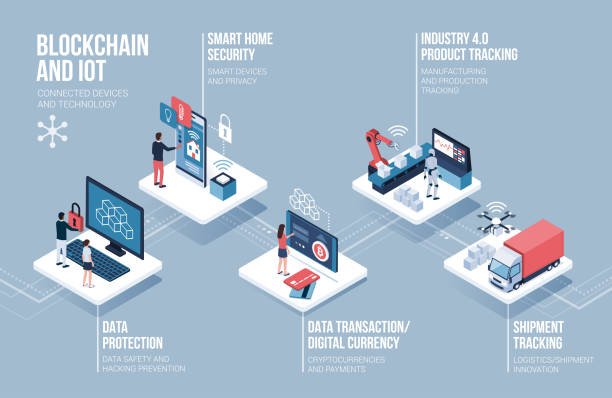Introduction
Blockchain technology is an innovation that is transforming the digital world today. In this article, we will explore the fundamentals of blockchain, which has become the backbone of cryptocurrencies. This technology not only secures and makes financial transactions transparent but is also being applied across various fields globally. Let’s start by understanding the basics of blockchain to comprehend this world better.
What is Blockchain?

Blockchain is a digital ledger that stores data in the form of a chain. Each block stores a record of transactions, and these blocks are linked together like a chain. Each block contains a cryptographic hash that includes the hash of the previous block, ensuring data integrity. Whenever a new transaction occurs, a new block is created and added to this chain. This process reduces the risk of data tampering and enhances security.
History of Blockchain
The history of blockchain dates back to 2008 when an unknown person or group named Satoshi Nakamoto published the Bitcoin white paper. This paper introduced the concept of blockchain technology, which was instrumental in making digital currency decentralized and secure. After Bitcoin’s success, blockchain technology began to be used in various applications where transparency and security were essential.
Relationship Between Cryptocurrencies and Blockchain

Cryptocurrencies, such as Bitcoin and Ethereum, are based on blockchain technology. Blockchain makes these currencies secure and transparent through a decentralized network. Every transaction on the cryptocurrency network is recorded in the blockchain ledger. This process helps track transaction history and resolves issues like double spending.
Key Features of Blockchain
Some key features of blockchain include decentralization, transparency, immutability, and security. Decentralization means that the blockchain network is not controlled by a single entity but is distributed among the network’s members. Transparency makes this technology a public ledger where all transactions are visible. Immutability means that once data is recorded, it cannot be changed. Security helps blockchain protect against tampering and fraud.
Types of Blockchain
There are two main types of blockchain technology: public and private. Public blockchains, like Bitcoin and Ethereum, are open and accessible to all users. Private blockchains, mainly used for businesses and enterprises, come with restricted access. Both types have their applications and advantages, and their choice depends on the use case.
Smart Contracts
Smart contracts are an important component of blockchain technology. These are self-executing contracts that automatically execute based on predefined rules and conditions. Smart contracts eliminate the need for intermediaries and increase transaction speed and efficiency. This technology is used in various applications, including finance, supply chain, and real estate.
Blockchain in Supply Chain

Using blockchain in supply chain management can enhance transparency and traceability. Blockchain technology can track every step in the supply chain, allowing verification of the authenticity and origin of goods. This reduces the risk of fraud and counterfeit goods. Companies can optimize and streamline their supply chains through blockchain.
Blockchain in Healthcare
In the healthcare industry, blockchain technology proves useful in securing and privatizing patient data. The decentralized and encrypted nature of blockchain secures patient medical records and protects against unauthorized access. Through this technology, doctors and healthcare providers have access to accurate and timely information, improving healthcare services.
Legal and Compliance Issues
The use of blockchain technology also raises legal and compliance issues. Countries and governments are developing regulations and standards for this technology to ensure legal compliance and data protection. It is essential to bring blockchain applications under regulatory frameworks to prevent misuse and fraud.
Future Trends and Challenges
Future trends in blockchain technology include scalability, interoperability, and energy efficiency. Scalability refers to the ability of blockchain networks to handle a large number of transactions. Interoperability ensures compatibility and communication between different blockchains. Energy efficiency addresses the environmental impact of blockchain, aiming to reduce energy consumption.
Blockchain and Financial Services
In financial services, the adoption of blockchain technology enhances transparency and efficiency. Banks and financial institutions are using blockchain to improve cross-border payments, fraud detection, and compliance reporting. This technology makes financial transactions faster, cheaper, and more secure, contributing to an improved global financial system.
Challenges of Blockchain
Despite its advantages, blockchain technology faces challenges. These include scalability issues, high energy consumption, and regulatory concerns. Scaling blockchain networks and handling large volumes of transactions can be challenging. High energy consumption, especially in proof-of-work blockchains, contributes to environmental impact. Regulatory concerns also pose a barrier that can affect the widespread adoption of the technology.
Education and Awareness
Education and awareness play a crucial role in the widespread adoption of blockchain technology. It is essential to educate people about the benefits and applications of this technology so they can understand its potential and use it effectively in their lives and businesses. Educational institutions and organizations are conducting workshops, seminars, and courses to promote understanding of this technology.
Conclusion
Blockchain technology has transformed the digital world, and its potential applications are expanding across various fields. This technology can improve transparency, security, and efficiency. However, it also has challenges and limitations that need to be addressed. Understanding and adopting blockchain can help us make the digital economy better and more secure.
If you want to learn more about the future trends and applications of blockchain technology, you should closely follow the basics and advancements of this technology.


